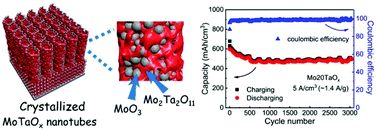A long-term stable aqueous aluminum battery electrode based on one-dimensional molybdenum–tantalum oxide nanotube arrays†
Abstract
Aluminum ion aqueous batteries (AIBs) are among the most promising candidates for high energy density devices due to the multivalent redox processes associated with Al3+ ion intercalation. However, only a few stable AIB electrode materials have been reported so far. MoO3 is a very promising electrode material due to its octahedral layered crystal structure which can accommodate multivalent cation by intercalation. However, the poor electrochemical stability of MoO3 and the sluggish intercalation kinetics of Al3+ ion in Mo oxides electrodes limit its practical application. In this work, we propose a strategy to overcome such shortcomings of MoO3 by fabricating electrodes composed of self-ordered one-dimensional (1D) MoTaOx nanotubes synthesized via electrochemical anodization of Mo–Ta alloy substrates. We show that this approach allows for direct incorporation of Ta in the Mo oxide nanotubes. The resulting MoTaOx nanotubes, composed of octahedral MoO3 and rhombohedral Mo2Ta2O11 phases, exhibit remarkable electrochemical stability and Al-ion storage properties in aqueous electrolytes that are superior to that of pristine Mo oxide or other most efficient electrode materials reported to date. Such MoTaOx nanotube-based electrodes can achieve a specific capacity of 1180 mA h cm−3 (337 mA h g−1, 141 μA h cm−2) at 1.25 A cm−3 (∼0.35 A g−1, 0.15 mA cm−2). More importantly, the capacity retention of such nanotube array electrodes remains above 83% of the initial capacity after 3000 cycles.

- This article is part of the themed collection: 2021 Nanoscale HOT Article Collection


 Please wait while we load your content...
Please wait while we load your content...